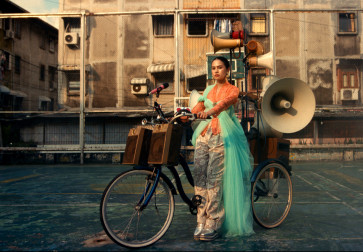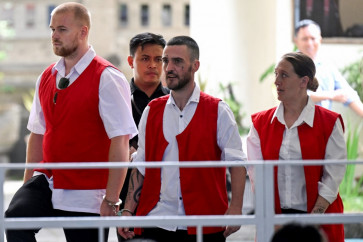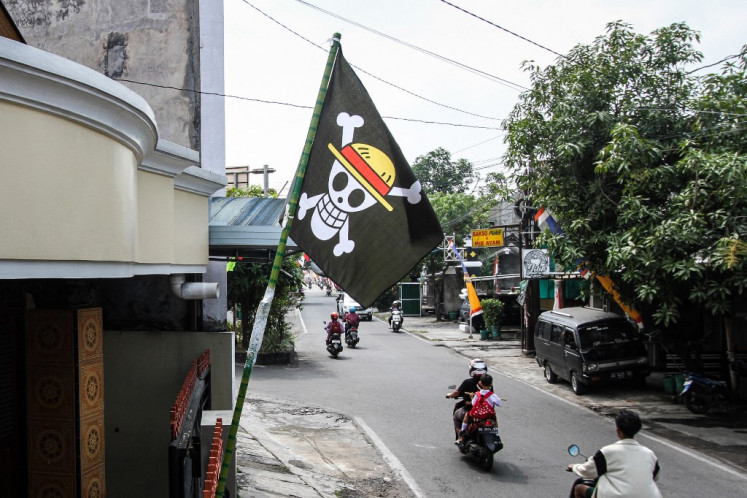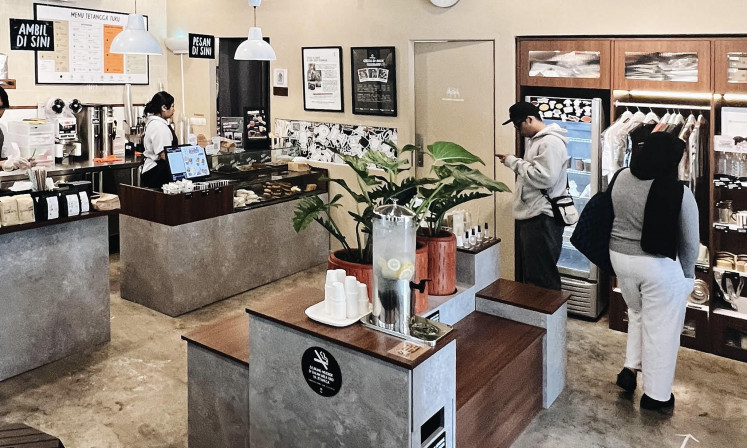Popular Reads
Top Results
Can't find what you're looking for?
View all search resultsPopular Reads
Top Results
Can't find what you're looking for?
View all search resultsWhere art is divine
In 1995, former deputy chief editor of Kompas, P
Change text size
Gift Premium Articles
to Anyone
I
n 1995, former deputy chief editor of Kompas, P. Swantoro, set up Lembaga Studi Jawa, a cultural center dedicated to the study of classical Javanese culture.
But, when P. Swantoro’s son Norbertus Nuranto took over the institution, Norbertus realized it was meant to be bigger and better. With this in mind, he welcomed artists, musicians, dancers and poets to express their artistic aspirations there.
Art space: Tembi Rumah Budaya is divided into four major areas: Bale Inap is a modern tropical resort that features traditional Javanese houses; BaleDokumentasi is a museum/offi ce; Bale Rupa is an exhibition hall; and Bale Karya is an art studio for selected resident artists. — Photo courtesy ofTembi Rumah Budaya
“The institution has since evolved. We are determined to conserve Indonesian culture – be it Javanese or non-Javanese. Today, the institution is simply known as Tembi Rumah Budaya [TRB],” Norbertus said.
Sitting on a 3,000-square-meter plot in the village of Tembi in Bantul regency, Yogyakarta, TRB consisted of a pendopo (traditional Javanese house), a museum, classrooms and offices. Unfortunately, a devastating earthquake that struck Yogyakarta and Central Java in May of 2006 destroyed the entire complex.
But Norbertus, a former management consultant with a degree in Japanese literature from the University of Indonesia, was not one to give up. He hired professional architects, rebuilt the pendopo, and bought nine traditional wooden houses unique to different ethnic groups in Java to adorn the complex. By 2007, the new cultural complex of Tembi Rumah Budaya was born.
For rest: Tembi Rumah Budaya’s owner, Norbertus, bought nine traditional wooden houses unique to different ethnic groups that exist in Java to adorn the complex.— Photo courtesy of Tembi Rumah Budaya
The newly revamped TRB is 2,500 square meters and functions as a commercial resort, museum, performing arts center and residence for budding artists. The complex is divided into four major areas: Bale Inap is a modern tropical resort that features traditional Javanese houses; Bale Dokumentasi is a museum/office; Bale Rupa is an exhibition hall; and Bale Karya is an art studio for selected resident artists.
“The vision of TRB is to nurture quality creative works produced by homegrown young artists. This is the place where there is no limit to creativity,” said Norbertus.
Over the years, TRB has also branched out into other business such as publishing, food and beverages and agriculture.
“We have published several Javanese literature books. We also have opened a restaurant that serves traditional food as described in the Surat Centhini [Old Javanese story describing the adventures of Sheikh Amongrogo] within the complex.
“And more recently, we have ventured into an agriculture business by supporting local farmers who want to get into the organic farming industry,” said the social entrepreneur who has a master’s degree in Southeast Asian studies from Cornell University.
Considering TRB’s contribution to the local art world, many would assume that Norbertus is himself an artist. But this assumption couldn’t be further from the truth. Although well-educated and cultured, he loosely referred to himself as a scavenger.
“I have a habit of collecting information many consider useless and irrelevant. In that sense, I am a ‘scavenger’”, he said, adding, “But if it wasn’t for my habit, I wouldn’t have known about the archeological traces of Plered and Kerto in the Tembi neighborhood.”
His habit of “scavenging” information derives from his interest in history. Born into a family that appreciated arts, education and knowledge – his paternal grandfather was a teacher and maternal grandfather, K.R.T. Purbaningrat, was a choreographer at the Yogyakarta Palace – Norbertus grew up in a cultured environment.
“Obviously, art runs in my veins. But my true passion is history. For me, TRB is a very personal project. To build and run it is to explore my personal history. For instance, to honor my paternal grandfather, I named the cottages in TRB after the towns where my paternal grandfather worked as a teacher,” he said.
“I also made TRB a haven for dancers to pay tribute to my maternal grandfather,” added Norbertus, who is also an avid art collector.
Supporter: Norbertus welcomes artists, musicians, dancers and poets toexpress their artistic aspirations at Tembi Rumah Budaya. — Photo courtesy of Tembi Rumah Budaya
When asked about his daily activities, Norbertus replied that his routine revolves around coffee, books and cigarettes. The 50-year-old said jokingly: “Well, my friends call me a geographical widower.”
His daughter, Lucy Nuranto, laughed shyly listening to his father’s dry humor. While Norbertus divides his time between Yogyakarta and Jakarta, Lucy and her mother are based in San Francisco.
“My wife, Sarah Maxim, works as the vice chair of the Center for Southeast Asia Studies at UC Berkeley,” Norbertus said, adding, “I didn’t want to be based there because when they decided to move back to the US, I felt that I was already too old to adapt to a new environment – I want to be surrounded by my elements here.”
Call him selfish, but his support for the local art world is certainly everything but egocentric.
“At this point in my life, I realize that young artists in this country need support from art patrons to be able to grow. This is one of the main reasons we created the artist-in-residence program at TRB,” said Norbertus, who along with a team of art experts, will choose those who will be granted a 3-month stay at TRB and a solo exhibition at the end of the program.
“There’s no limitation in terms of artistic expression here – you can sing, dance, play music, paint, write poetry – as long as you can come up with a concrete result at the end of the program,” he said.
— Photos courtesy of Tembi Rumah Budaya












